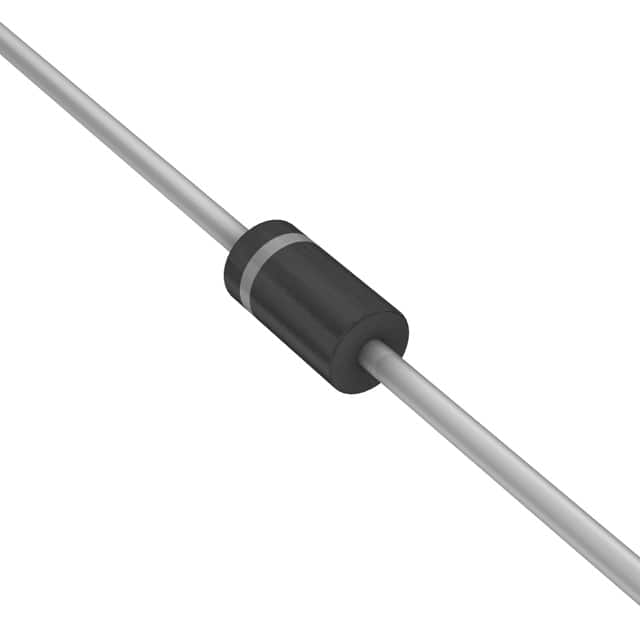Viz Specifikace pro podrobnosti o produktu.

MUR130 Diode: Encyclopedia Entry
Introduction
The MUR130 diode is a crucial component in electronic circuits, belonging to the category of rectifier diodes. This entry provides an overview of the MUR130 diode, including its basic information, specifications, pin configuration, functional features, advantages and disadvantages, working principles, application field plans, and alternative models.
Basic Information Overview
- Category: Rectifier Diode
- Use: The MUR130 diode is primarily used for converting alternating current (AC) to direct current (DC) in power supply applications.
- Characteristics: It exhibits low forward voltage drop, high surge capability, and fast switching speed.
- Package: The diode is typically available in a DO-201AD package.
- Essence: It serves as a reliable component for rectification and power conversion.
- Packaging/Quantity: The MUR130 diode is commonly packaged in reels or tubes, with quantities varying based on manufacturer specifications.
Specifications
- Forward Voltage Drop: Typically around 0.85V at 1A
- Reverse Voltage: 300V
- Average Rectified Current: 1A
- Peak Surge Current: 30A
- Operating Temperature Range: -65°C to +175°C
Detailed Pin Configuration
The MUR130 diode has a standard two-pin configuration, with the anode and cathode terminals clearly marked for easy identification.
Functional Features
- Fast Switching Speed: Enables efficient AC to DC conversion.
- Low Forward Voltage Drop: Minimizes power loss during operation.
- High Surge Capability: Withstands sudden voltage spikes without damage.
Advantages and Disadvantages
Advantages
- Efficient power conversion
- Reliable performance under surge conditions
- Compact form factor
Disadvantages
- Limited reverse voltage tolerance compared to some other diode types
- Sensitive to temperature extremes
Working Principles
The MUR130 diode operates based on the principle of unidirectional current flow, allowing current to pass freely in one direction while blocking it in the opposite direction. When forward-biased, it conducts current with minimal voltage drop, facilitating the conversion of AC to DC.
Detailed Application Field Plans
The MUR130 diode finds extensive use in various applications, including: - Power supply units - Battery chargers - Inverters - Motor drives - Lighting systems
Detailed and Complete Alternative Models
- 1N4007: A widely used general-purpose rectifier diode with similar characteristics to the MUR130.
- FR107: Fast recovery rectifier diode suitable for high-frequency applications.
- UF4007: Ultrafast rectifier diode with superior switching capabilities.
In conclusion, the MUR130 diode serves as a vital component in power electronics, offering efficient rectification and reliable performance. Its unique combination of characteristics makes it well-suited for diverse applications, despite certain limitations. Understanding its specifications, functional features, and alternative models is essential for effective utilization in electronic circuit design.
Word Count: 410
Seznam 10 běžných otázek a odpovědí souvisejících s aplikací MUR130 v technických řešeních
What is the MUR130 diode used for?
- The MUR130 diode is commonly used for rectification and freewheeling applications in power supplies, inverters, and other electronic circuits.
What is the maximum forward voltage drop of the MUR130 diode?
- The maximum forward voltage drop of the MUR130 diode is typically around 0.85 volts at a forward current of 1 ampere.
What is the reverse recovery time of the MUR130 diode?
- The reverse recovery time of the MUR130 diode is typically around 35 nanoseconds, making it suitable for high-frequency applications.
Can the MUR130 diode handle high currents?
- Yes, the MUR130 diode is capable of handling relatively high average forward currents, typically up to 1 ampere.
Is the MUR130 diode suitable for fast-switching applications?
- Yes, the MUR130 diode's fast reverse recovery time makes it well-suited for fast-switching applications such as switching power supplies and inverters.
What is the maximum reverse voltage rating of the MUR130 diode?
- The MUR130 diode has a maximum reverse voltage rating of 300 volts, making it suitable for medium-voltage applications.
Can the MUR130 diode be used in parallel to handle higher currents?
- Yes, the MUR130 diode can be used in parallel to handle higher currents while maintaining balanced current sharing.
Does the MUR130 diode require a heatsink for high-power applications?
- For high-power applications, it is recommended to use a heatsink to ensure proper thermal management and reliability.
What are the typical applications of the MUR130 diode?
- Typical applications of the MUR130 diode include flyback diode in power supply circuits, freewheeling diode in motor drive circuits, and general-purpose rectification.
Is the MUR130 diode available in surface mount packages?
- Yes, the MUR130 diode is available in surface mount packages, making it suitable for compact and space-constrained designs.

